Rebecca’s Recipe of the Week: Fermented Carrots
According to Dr Bill Schindler, fermented carrot sticks not only taste more interesting than ordinary carrot sticks, but also contain lots of probiotics. I can’t comment on the merits of this claim, but can confirm that fermented carrot sticks are really tasty. They retain the pleasant crunch of raw carrots, but are a little softer—midway between raw and cooked. The brine imbues each carrot stick with a salty tang, and the short fermentation adds an additional dimension. As fermentations go, this is really, really easy. You basically pack the carrots in a jar, add salty water, and leave them for a few days.
Serve your fermented carrot sticks as a nibble with drinks, or add them to a salad.
Fermented Carrot Sticks
Ingredients
3-6 carrots
sea salt
1 glass jar large enough to hold your carrots
kitchen scales of the sort you can zero
Method
Peel and trim the carrots. Cut them into sticks of a size you’d like to munch on.
Put the empty glass jar on the scales and zero the scales.
Leaving the jar on the scales, stand the carrot sticks neatly into it, packing them as tight as possible. With the carrot-filled jar still on the scales, pour in enough water to cover the carrots but leaving 2cm between the top of the water and the top of the jar. Note down the weight in grams.
Now do some maths to work out how much salt you will need. Multiply the weight by 0.02. This is the amount of salt you need. So, for instance, if the vegetable mixture weighs 1000grams, then you need 20 grams of salt.
Measure out the amount of salt you will need and put it into a medium bowl.
Drain the water from the carrots into that bowl. Mix until the salt is dissolved, and then pour the salty water back into the jar to cover the carrots.
Cover your jar with a piece of clean cloth secured by a rubber band. Put it somewhere tranquil and temperate—an ideal temperature is around 17C. Leave for 3-5 days to ferment. Try tasting a carrot after 3 days, and see if you like its crunchy, salty flavour. Once you’re happy with the flavour, move the jar to the fridge, where it will keep for up to 3 months.
Recipe adapted from Bill Schindler, Eat Like a Human (2021).
Rebecca’s Recipe of the Week: Registrar’s Spanish Chicken and Chorizo Shepherd’s Pie
In Memoriam: Jonathan Nicholls
This week’s recipe is in memory of Jonathan Nichols, a friend and Leamington resident who sadly and suddenly died this past week. He served for a number of years as Registrar at first Warwick University, and then at Cambridge. This recipe, for Registrar’s Spanish Chicken and Chorizo Shepherd’s Pie, comes from a different Warwick Registrar (Ken Sloan), but through its name it can perhaps also celebrate Jonathan, and his enthusiasm for good food and a nice glass of wine.
Registrar’s Spanish Chicken and Chorizo Shepherd’s Pie
Ingredients
1 tablespoon Sunflower oil
2 Onions, diced
100 grams Leeks, thinly sliced
3 cloves Garlic, crushed
50 grams Chorizo, chopped
1 teaspoon Paprika
5 sprigs of Thyme
500 grams Tomato Passata
1 tablespoon Tomato Purée
250 millilitres Chicken Stock
100 millilitres Spanish Red Wine (optional)
500 grams chopped Chicken Breast
800 grams Sweet Potatoes, diced
1 ounce Butter
Salt and Pepper
30 grams Jalapenos
2 Red Peppers, diced
75 grams Ewe’s Cheese, grated
Mixed Salad
Method
Heat oven to 180C.
Heat the oil in a large frying pan. Fry the onions and the leeks for 5-10 minutes. Add the garlic and chorizo and cook for another 5 minutes. Stir in the paprika, thyme, tomato passata, tomato purée, chicken stock and the optional red wine, and bring to a simmer. Add the chicken, cover, and cook over a low heat for at least an hour until the sauce has reduced.
Meanwhile, boil a pan of hot water. Add salt and sweet potato chunks, and return to the boil. When the sweet potato has softened drain it, add butter, salt and pepper, and then mash. Leave to one side.
Once the sauce in the chicken mixture has reduced, remove the thyme stem, and then put the mixture into an oven-proof dish. Stir in jalapenos and peppers. Spread the mashed sweet potato over the top. Sprinkle the cheese on top of the sweet potato.
Cover with foil and bake for 25 minutes, then remove foil and bake for a further 10 minutes. Remove from oven and serve with mixed salad.
Ken Sloan’s recipe appears in Simple Scoff The Anniversary Edition, ed. Rebecca Earle (2015).
Rebecca’s Recipe of the Week: Ukranian Borscht
Some of you may have seen that Russian chef Alissa Timoshkina has teamed up with Ukrainian chef Olia Hercules to raise money for Ukraine. I thought this week I would repeat this recipe for their excellent borscht.
Borscht
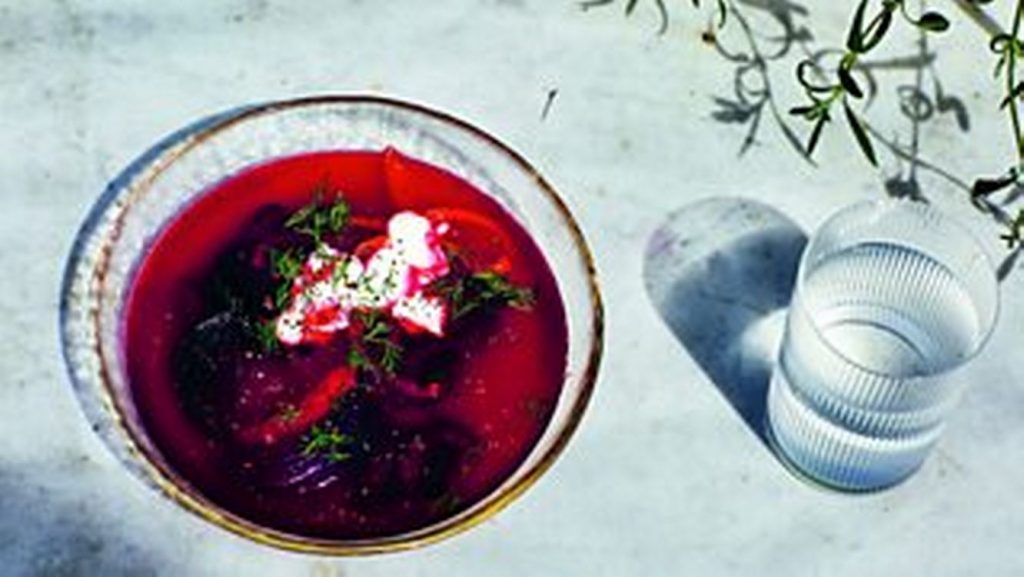
Serves 4
Ingredients
unrefined sunflower oil, for frying and roasting
1 large onion, finely diced
1 carrot, peeled and grated
6 raw beetroots
2 red peppers
2 tablespoons tomato purée
2 litres cold water
2 bay leaves
1 tablespoon black peppercorns
1 tablespoon coriander seeds
1 tablespoon fennel seeds
4 garlic cloves, peeled
bunch of dill
small bunch of flat leaf parsley
2 garlic cloves, grated
500g red cabbage sauerkraut
2 tablespoons pomegranate molasses
1 red onion
1 tablespoon brown sugar
400g can red kidney beans
2 teaspoons smoked paprika
4 tablespoons soured cream
salt
Preparation
Heat up a tablespoon of sunflower oil in a large pan and fry the onion and carrot for about 8 minutes until golden. Meanwhile, peel and grate 2 of the beetroots and core, deseed and thinly slice 1 red pepper. Add the vegetables to the pan together with the tomato purée and a splash of water. Season with salt to taste and fry for a further 5–8 minutes.
Top with the measured cold water, add the bay leaves along with the peppercorns and all the seeds, whole garlic cloves and half the bunches of dill and parsley. Season with a tablespoon of salt and bring to the boil. Reduce the heat, add the grated garlic and half the sauerkraut with its brine and simmer, covered, over a low heat for 40 minutes–1 hour.
Turn off the heat and let the borsch rest for another hour, while you prepare the rest of the elements.
So far, so good, but here is where the recipe starts to deviate from the norm quite a lot: to prepare the vegetables that will grace the plate and also add extra flavour and texture to the soup, you will need to do a bit of roasting.
Start by preheating the oven to 160°C fan/Gas Mark 4. Peel the remaining 4 beetroots, cut into wedges and dress with oil, salt and the pomegranate molasses. Peel the red onion, cut into wedges and season with salt and the brown sugar to bring out their sweetness and promote caramelization. Place on a roasting tray with the beetroot and roast together for 30 minutes. Drain the kidney beans, then dress them with salt, oil and the smoked paprika. Core and deseed the remaining red pepper, then cut into thin strips and dress with salt and oil. Roast the beans and pepper together, as they will need only 10–15 minutes.
When ready to serve, strain the broth through a sieve or a muslin cloth, discarding the solids. All we need is that rich broth! Reheat again if necessary. Next, create layers of texture and flavour in each bowl by adding a heaped tablespoon of the remaining sauerkraut to each, as well as a handful of roasted beetroot, onion, kidney beans and red pepper. Top each bowl with the hot broth and add a dollop of soured cream and a generous sprinkle of the remaining dill and parsley, chopped. The intensity of the flavours and textures of this dish is beyond words, while the look of the bowl will seduce the eye without a doubt.
Recipe from Alissa Timoshkina, Salt & Time: Recipes from a Russian Kitchen (2019).
Rebecca’s Recipe of the Week: Vaguely Turkish Greens
This is based very loosely on a classic Turkish dish called çilbir, which consists of soft poached eggs topped with garlicky yoghurt and a butter sauce spiced with Aleppo pepper. I’ve also had the same pair of toppings on pasta. Here the garlic yoghurt and spicy butter are combined with fresh greens and served on a base of lemony rice with chickpeas. Having two sauces gives this quick and easy dish a luxurious feel.
Vaguely Turkish Greens, Serves 2
Ingredients
about 200ml full-fat yoghurt
1 clove of garlic, mashed to a paste with ½ teaspoon salt
2 tablespoons butter
¼ teaspoon smoked paprika (I used the ‘sweet’ variety). If you have some Aleppo pepper (pul biber), use that instead.
450g spinach, chard, or other greens
about 1 cup of cooked brown rice
¾ of a tin of chickpeas (the tins that combine black and ordinary chickpeas look particularly nice)
1 tablespoon olive oil
zest and juice of half a lemon
salt and pepper
Method
In a small bowl, combine the yoghurt and crushed garlic. Taste it: it should be salty and garlicky. Add a bit more salt if you like and set aside.
Put the butter and the smoked paprika in a small pan or microwave-safe jug and warm gently until the butter is melted. Set aside.
Wash the greens and put them in a large pan. Steam or boil until they are tender—about 4 minutes.
Meanwhile, combine the cooked rice, chickpeas and olive oil and warm the whole thing in a microwave or on the stove. Once it’s warm add the lemon zest and juice, and season to taste.
Drain the greens, and use a wooden spoon to press out as much water as you can. I also use a pair of kitchen scissors to snip the cooked greens into smaller units as they sit in the colander, but you don’t need to do this.
Now assemble the dish: divide the chickpea rice into two bowls. Top each with half the cooked, drained greens. Dollop half the garlic yoghurt on top of each. It looks nice if you make several discrete dollops, rather than just pouring it over the top—that way you can see the greens underneath. Now drizzle the melted paprika butter over the yoghurt, making a red criss-cross across the white yoghurt and green greens. Top with a final grind of black pepper and enjoy. A glass of white wine is a pleasant accompaniment.
Rebecca’s Recipe of the Week: Nigel Slater’s Pappardelle with Leeks (Classic Recipe)
‘Ribbons of silky pasta merge marvellously with soft, salty leeks’, wrote Nigel Slater in Guardian—and so they do.
Pappardelle with Leeks, Serves 2.
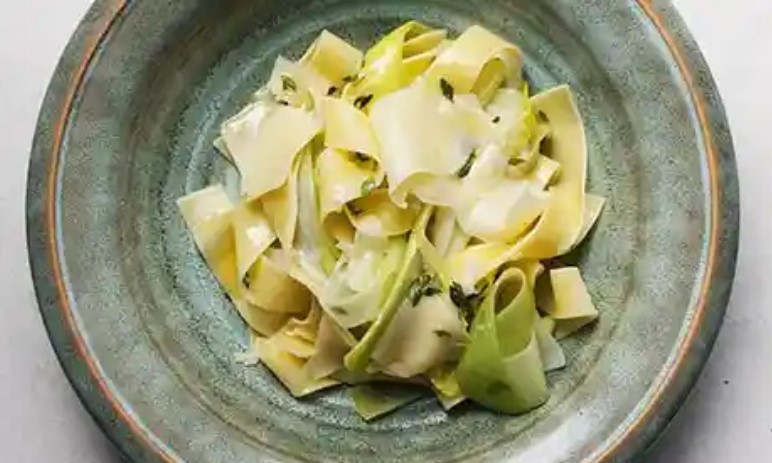
Ingredients
500g leeks
100g butter
10 sprigs of thyme or tarragon
salt and pepper
250g pappardelle, or other ribbon-shaped pasta
100g gruyère, sliced thin
Preparation
Cut off the bottoms and the tough green tops of the leeks. Cut them in half (or quarters if they are thick) the long way. Wash them thoroughly under cold running water.
Melt the butter in a pan and then add the leeks. Let them stew slowly until they are soft and tender.
While they are stewing, remove the leaves from the thyme (or tarragon) and add the leaves to the leeks. Season lightly.
Cook the pappardelle in generously salted, boiling water until al dente. Drain, leaving a bit of water to cling to the pasta, and add to the leek pan. Toss the pasta with the buttery leeks.
Scatter the gruyère slices on top, letting them melt in the warmth of the butter and leeks, and serve.
Recipe adapted from Nigel Slater, Guardian, 24 Sept. 2013.
Rebecca’s Recipe of the Week: A Soothing Winter Soup
This makes a very good Friday night dinner. The pumpkin (or squash) soup is silky and rich, despite its simple ingredients, and the multiple toppings add complexity and, in the case of the pumpkin seeds, crunch. The rice provides a backdrop for the ginger-spiked soup and rosemary butter. You will leave the table feeling well-fed and comfortable in your tummy.
Pumpkin and Rice Soup, Serves 2-3 as a main
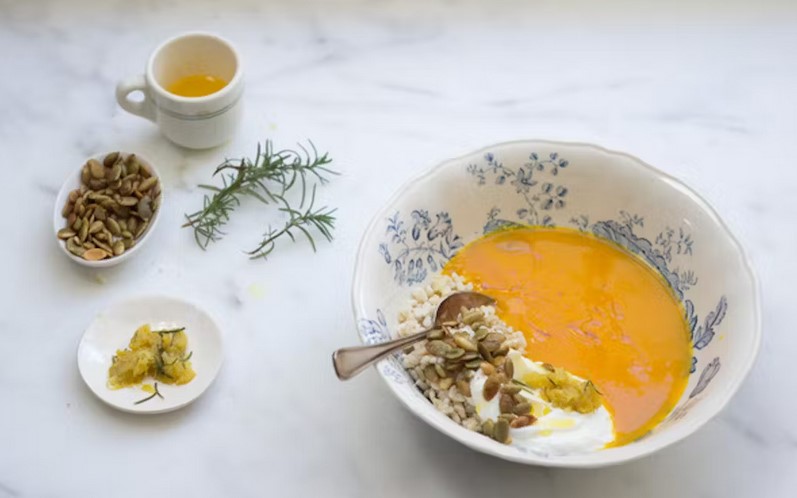
Ingredients
For the Soup
1 tablespoon butter
1 large onion, peeled and chopped
½ dried chile, chopped and de-seeded if you prefer
1 teaspoon salt
1kg squash or pumpkin
1.2 litres of water
2 teaspoons grated fresh ginger, or a bit more, to taste
To Serve
cooked brown rice, warm
plain yoghurt
toasted pumpkin seeds
lemon-ginger-rosemary butter (see below)
Method
In a large pot melt the butter over medium-high heat. Add the onion, chile and salt. Turn the heat to low and cook for 5-7 minutes or until the onion is softened.
Meanwhile, prepare the squash or pumpkin. Peel it, remove any seeds and cut it into 2cm chunks. You need about 700g once it’s been peeled and de-seeded.
When the onion is soft add the squash or pumpkin and water. Bring to a simmer and cook gently until the squash or pumpkin is soft. This will take between 15 and 25 minutes, depending on the squash or pumpkin.
Remove from the heat and add the ginger. Use a stick blender to puree until it is smooth. Add a bit more water if it seems too thick for your taste.
To serve, put a big scoop of rice in each soup bowl and top with the soup. Decorate with some yoghurt, toasted pumpkin seeds and lemon-ginger-rosemary butter.
Lemon-Ginger-Rosemary Butter
Ingredients
50g butter
rosemary leaves from a 10cm sprig, chopped
zest of 1 lemon
1 teaspoon grated fresh ginger
pinch of salt
Method
Melt the butter in a small pan over medium heat, until the butter starts to brown. Keep an eye on it so it does not burn.
Remove from the heat and stir in the other ingredients. Let sit for at least 5 minutes, to let the flavours meld.
Recipe adapted from 101 Cookbooks
Rebecca’s Recipe of the Week: South Indian Beetroot and Coconut
The Guardian calls this a dip, and doubtless it would be nice with something dipped in it, but I thought it worked very well as a thing-in-itself. If you are worried that would be too much coconut, it isn’t.
South Indian Beetroot and Coconut ‘Dip’
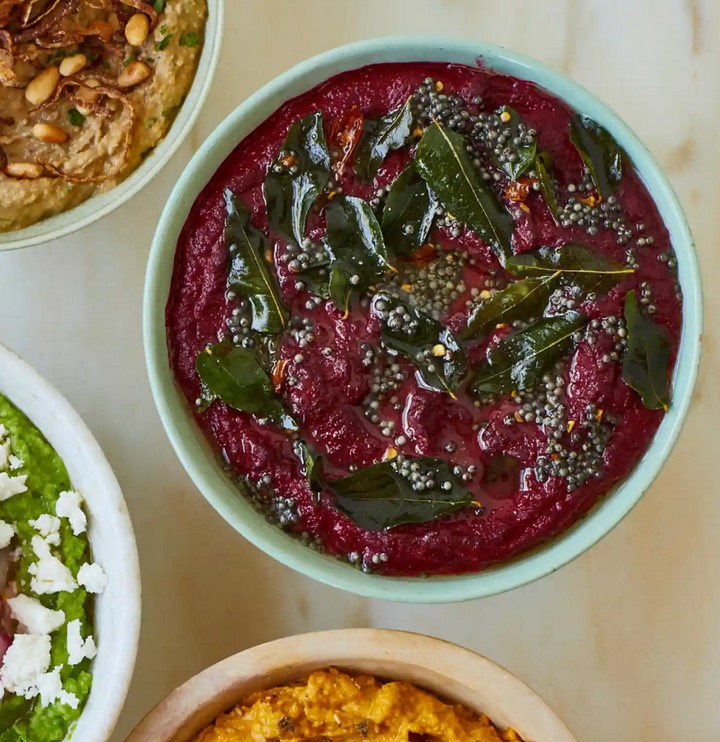
Serves 4 as part of a larger spread.
Ingredients
For the Beetroot
1 drizzle rapeseed oil
4 medium beetroot, peeled and grated
200g plain yoghurt
salt
1 teaspoon sugar
juice of 1 lime
For the Coconut Paste
½ teaspoon brown mustard seeds
1 teaspoon sesame seeds
½ teaspoon cumin seeds
8 cashews, toasted in a dry pan
100g fresh or frozen coconut, grated
1 tablespoon grated ginger
1 green chile, de-seeded if you desire
For the Topping
2 tablespoons coconut or rapeseed oil
2 teaspoons brown mustard seed
1 pinch asafoetida
15 curry leaves
1 dried chile
Preparation
Begin with the beetroot: In a large pan heat the rapeseed oil. When it is hot sauté the grated beetroot until is beginning to get tender, about 8-10 minutes.
Meanwhile, make the coconut paste: combine the mustard, sesame and cumin seeds in a blender and whizz them up. Add the cashews, coconut, ginger, chile and a little water. Whizz again until it is a smooth paste. Add more water if you need to.
Stir this coconut paste into the beetroot and cook over low-medium heat for another 5 to 8 minutes. Remove from the heat and leave to cool.
Once it is cool, blitz it up in the blender until it is smooth. Add the yoghurt and salt to taste. Add the sugar and lime juice, blend, and tip into a serving bowl.
When you are ready to eat prepare the topping: heat the coconut or rapeseed oil in a small frying pan. Once it is hot add the mustard seeds. As soon as they start to pop add the asafoetida, curry leaves and chile. Toss for another 30 seconds and then pour this over the beetroot and serve.
Recipe adapted from The Guardian, 12 June 2021.
Rebecca’s Recipe of the Week: Miso-Harissa Squash
Miso and harissa on their own pack a punch. Combined they are even better. The spicy-salty flavour goes superbly with the sweetness of roast squash, while the potatoes add a calming back-note. Stir in some shredded kale and top with toasted nuts, and you have a complete meal. You could fancy it up with some yoghurt, or serve it alongside a bit of grilled meat or fish, if you liked.
Miso Harissa Roast Squash
Serves 2-4
Ingredients
225g small potatoes
350g squash
60ml olive oil
60ml white miso
1 tablespoon harissa
3 tablespoons lemon juice
50g kale, de-stemmed and finely chopped
4 radishes, sliced thin (optional)
40g toasted almonds or pumpkin seeks
Method
Preheat the oven to 200C.
Cut the potatoes into slices the size of your thumb. Peel the squash if you don’t like the skin, and scoop out the seeds. (You can make these into a tasty nibble by soaking them overnight in salty water, draining, and then baking for about 10 minutes at 180C.) Cut the squash into 1cm wedges. Put the potatoes and squash in a large bowl.
In a small bowl whisk together the olive oil, miso and harissa. Toss with the potatoes and squash with half the olive oil-miso-harissa mix, and put onto a baking sheet. Bake for 25-30 minutes, or until the vegetables are tender and starting to brown a bit. Toss them once or twice along the way. Watch them to make sure they don’t burn.
Meanwhile, whisk the lemon juice into the remaining olive oil-miso-harissa mixture. Taste it to see if you would like to add more olive oil, etc. Stir in the kale.
When the squash and potatoes are tender, put them in a serving bowl and toss with the kale mixture. Serve topped with the radishes (if you wish) and toasted nuts/seeds.
Recipe adapted from Heidi Swanson, 101 Cookbooks
Rebecca’s Recipe of the Week: A Flavoursome Mash
Yotam Ottolenghi recommends serving this root vegetable mash with either roast chicken or his very tasty wine-braised shallots (link: https://www.theguardian.com/lifeandstyle/2009/nov/28/root-mash-braised-shallots-recipe-ottoleghi). I’ve cut down the butter a bit as it seemed plenty rich with 35g of butter, but feel free to add the full 70g if you’d like. I don’t think the ratio between the vegetables needs to be observed religiously.
Ottolenghi Root Mash
serves 4-6
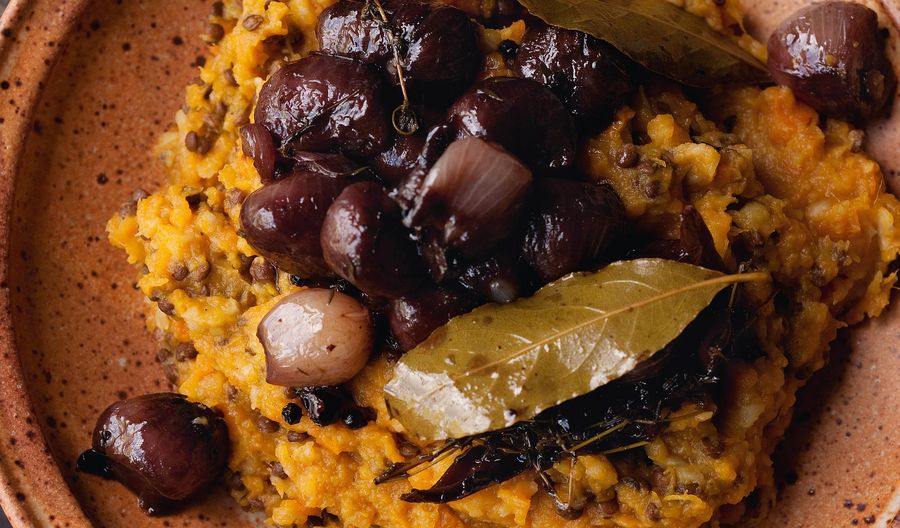
Ingredients
80g Puy lentils
300g celeriac, peeled and cut into chunks
300g carrots, peeled and cut into chunks
300g squash, peeled and cut into chunks
600g sweet potato, peeled and cut into chunks
35g butter
1 tablespoon maple syrup
1½ teaspoons ground cumin
1 teaspoon salt
black pepper (to taste)
Preparation
Bring a pan of water to the boil and add the lentils. Reduce the heat and simmer for about 25 minutes, or until tender. Drain and set aside.
Bring a large pan of water to the boil and add the celeriac and carrots. Cook for 10 minutes. Add the squash and sweet potato and cook for a further 10-15 minutes, or until everything is tender. Drain, shaking off as much liquid as possible.
Return the vegetables to the pan and mash well with a potato masher. Add the butter, maple syrup, cumin, salt, and black pepper and mash a bit more. Add the lentils, and taste to see if you would like more salt or pepper.
Recipe adapted from Yotam Ottolenghi, Plenty More (2014).
Rebecca’s Recipe of the Week: Mezze-style Carrots
The honey helps make the carrots glazed and sticky, as well as sweet. The sharp tahini-yoghurt sauce contrasts well with this.
Honey Roasted Carrots with Tahini Yoghurt
Serves 2-4 alongside other dishes
Ingredients
for the roast carrots
1.3kg carrots
60g runny honey
1 tablespoon olive oil
1 tablespoon coriander seeds, toasted in a dry pan and lightly crushed
1 teaspoon cumin seeds, toasted in a dry pan and lightly crushed
7g whole thyme sprigs
1 teaspoon salt
several grinds of black pepper
1½ tablespoons coriander leaves, roughly chopped (to garnish)
for the tahini-yoghurt sauce
1 garlic clove
pinch of salt
40g tahini
130g thick yoghurt (Greek or kerned is ideal but whole-milk plain yoghurt will work too)
2 tablespoons lemon juice
Preparation
Prepare the carrots: Heat your oven to 200C. Peel the carrots. If they’re thick cut them into smaller batons of about 2cm by 6cm. Put them in a large bowl with all the other carrot ingredients aside from the coriander leaves. Mix them well and then spread them in a single layer on one or more baking trays. Put them in the oven and roast for 30-40 minutes, stirring a few times, until they are soft and glazed. Remove them from the oven.
Prepare the tahini-yoghurt sauce: While the carrots are cooking prepare the tahini-yoghurt sauce: crush the garlic with the salt in a mortar and pestle. Transfer the salt-garlic mix to a small bowl and whisk in the other ingredients. Taste and see if you would like more salt or lemon juice.
To serve: spread the carrots on an attractive platter, and top with a few spoonfuls of the sauce and the coriander leaves. Serve warm or at room temperature with the remaining sauce on the side.
Recipe adapted from Guardian, 12 April 2013.